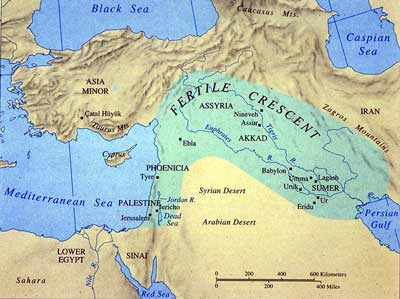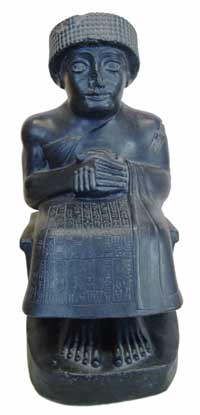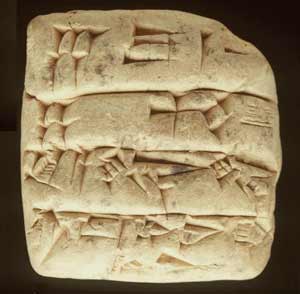
Map showing location of Ancient Sumer
Neil Faulkner Archive | ETOL Main Page
Marxist History
Published online by Counterfire, 15 July 2010.
Copied with thanks from the Counterfire Website.
Marked up by Einde O’Callaghan for the Encyclopaedia of Trotskyism On-Line (ETOL).
This week Neil Faulkner looks at the rise of the first ruling classes as the surplus created through the increasing productivity of human labour allowed a section of society to live without producing.

Map showing location of Ancient Sumer |
Prehistoric Sumer, a tract of land in the Tigris-Euphrates delta of southern Iraq, was a mixture of swamp and desert. Here, around 3000 BCE (before the common era), Neolithic pioneers created the original Garden of Eden.
They drained the swamps and irrigated the sandbanks between them. Doing so, they created fields of exceptional fertility. In 2500 BCE, the average yield on a field of barley was 86 times the sowing.
We know this from written records inscribed on baked-clay tablets. The Sumerians invented writing because the complex urban society they created required detailed record-keeping.
Ancient Sumer was roughly the size of modern Denmark. Once its rich soils were under cultivation, it could produce massive agricultural surpluses. These made possible a qualitative shift from living in villages to living in towns. Sumer accomplished an ‘urban revolution’.
The tells of Sumer are flat-topped artificial mounds formed by thousands of years of settlement. Layers of soil representing levelled mud-brick buildings tell the story of successive generations of inhabitants. They show Copper Age villages turning into Bronze Age cities between the fourth and third millennium BCE.

Sumerian ziggurat-temple |
Excavations have revealed cities dominated by large temples and artificial mounds known as ‘ziggurats’. At Erech, a ziggurat of ‘Early Dynastic’ date (c. 2900–2300 BCE) was 10 m high, built of sun-dried bricks, faced with thousands of pottery goblets, and topped by an asphalt platform.
The city as a whole, with its residential and industrial districts, covered two square miles.
The temples – and estates in the surrounding countryside to support them – belonged to the gods. The territory of Lagash was divided among some 20 deities.
The goddess Ba'u owned 17 square miles. Some of this was allocated to individual families. Some was worked as Ba'u’s personal estate by wage-labourers, tenant-farmers, or ‘clansmen’ doing customary labour-service.
In the absence of Ba'u, her property was managed by temple priests. Many of Ba'u’s people held only 0.8 to 2.5 acres. But one high temple official is known to have held 35.5 acres.
The priests formed an elite, with private wealth from their own estates, and collective control over the wealth of temple estates.
Wealth made the priests powerful, and power was used to accumulate more wealth. A decree of Lagash aimed to restore the old order ‘as it had existed from the beginning’. It records that priests were stealing from the poor, practising various kinds of extortion, and treating temple land, cattle, equipment, and servants as their private property or slaves.

The City Governor of Lagash |
From the ranks of the priests came ‘city-governors’ (later styled ‘kings’). At Lagash, the city-governor was high priest of the chief god and commander-in-chief of the citizen army. He enjoyed the use of 608 acres of Ba'u’s estate.
The city-governor of Lagash was one of many rulers, for Sumer was divided into separate city-states. These were often at war. The Standard of Ur depicts four-wheeled chariots trampling enemies, spearmen in helmets and metal-studded cloaks, and naked prisoners in front of the king.
Each polity lived in fear of its neighbours. Each had land, flocks, granaries, treasure, and a workforce to protect. Military power was imperative for defence.
But military power, once acquired, could be used proactively. Pre-emptive aggression might be the best guarantee of future security. Predatory aggression might enhance the wealth and power of a ruler.
Military power also had an internal function. The state – the ruler, the priests, a bureaucracy of officials and clerks, and the armed bodies of men they commanded – was a mechanism for upholding the new social order of the city.
Bureaucracy was itself an instrument of class power. The complexity of urban society demanded writing for keeping records, standardised weights and measures for trade, and geometry and arithmetic for land measurement.
New categories of specialist were trained in these arts. Their education was esoteric and exclusive. The state hierarchy imbued them with authority and status.
Older categories of specialist – traders and artisans – were also enmeshed in the new class structure. There was no free market. The economy of the ancient city was ‘embedded’ in the political order. Rulers controlled what was traded, where it was sold, and by whom. In particular, they maintained a monopoly of metals, especially bronze and gold.
Early Dynastic Sumer was the world’s first fully-formed class society. At the bottom were slaves. Above them were commoners of subordinate status. Above these were free citizens.

Sumerian cuneiform baked-clay writing tablet |
One baked-clay tablet refers to 205 slave girls and children, probably employed in a centralised weaving establishment. Another describes the occupational hierarchy at the temple of Ba'u in Lagash. At the top were clerks, officials, and priests. At the bottom were bakers, brewers, and textile-workers, many of them women, many of them slaves.
The houses excavated at Eshnunna reveal clear class differences. The larger houses on the main roads occupied 200 square metres or more. But smaller houses, often only 50 square metres and located in narrow alleys, were far more numerous.
Class inequality was resented and resisted. Sumerian tablets allude to the tensions. It was not based on consensus. It had to be imposed and maintained by force.
How had a minority acquired the power to elevate itself above the majority? What enabled the few to accumulate wealth at the expense of the many?
Class is both a social relationship – between rich and poor – and an economic process – of exploitation and surplus accumulation. It has to be continually reproduced. And because it is contested, this involves class struggle.
The rulers’ drive for wealth and power gained traction from the combination of poverty and property. This iron couplet holds all pre-industrial societies in a vice-like grip.
Poverty is a general condition. Traditional agricultural economies do not produce enough to provide abundance for all. Sometimes they do not produce enough to provide even the necessities.
Property is a privileged a priori claim to scarce resources. It allocates wealth to certain individuals, families, landowners, temples, tribes, or city-states. Property can be private or collective, but is never universal.

The Standard of Ur |
This contradictory couplet – poverty and property – gives rise to class inequality, state power, and warfare.
The high-priests and war-chiefs of prehistoric Sumer entered the class struggle with the advantage of publicly sanctioned authority as religious and military specialists. This gave them control over a growing surplus. Later, when their authority was questioned, they found they had the power to dispense with public sanction.
Once it was accumulating and consuming surplus in its own interest – not in that of society as a whole – the Sumerian elite constituted a ruling class of exploiters: the first in history.
Neil Faulkner Archive | ETOL Main Page
Eleven Reasons to Fight
Last updated on: 13 February 2022